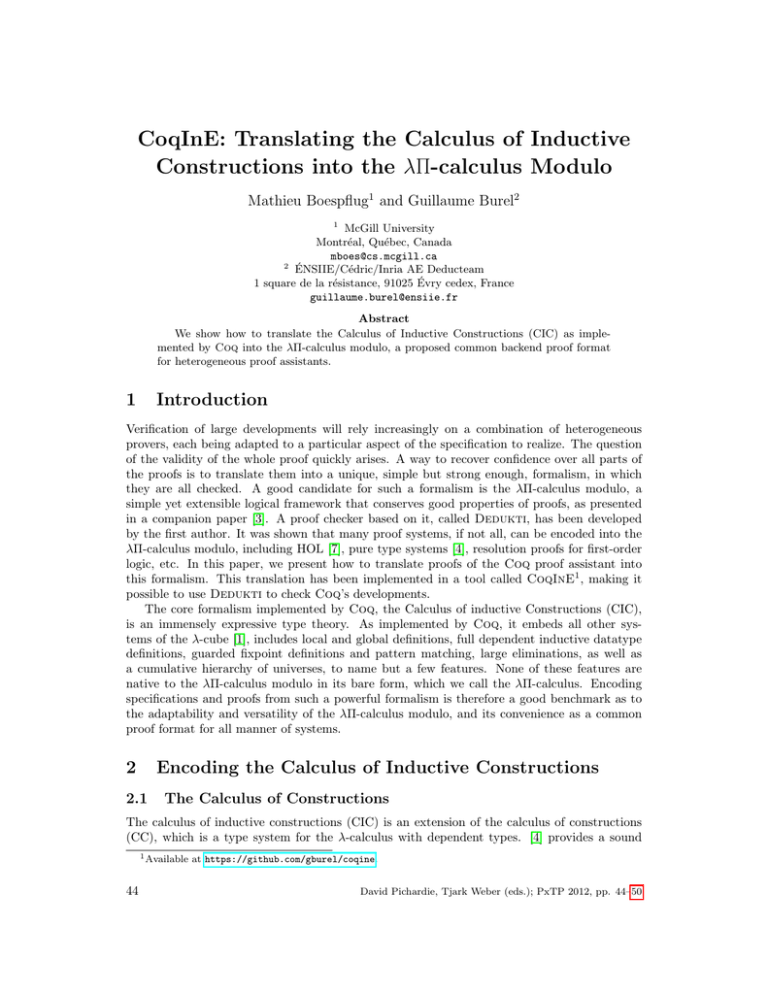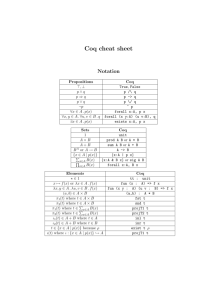CoqInE: Translating the Calculus of Inductive - CEUR
advertisement

CoqInE: Translating the Calculus of Inductive
Constructions into the λΠ-calculus Modulo
Mathieu Boespflug1 and Guillaume Burel2
1
McGill University
Montréal, Québec, Canada
mboes@cs.mcgill.ca
2
ÉNSIIE/Cédric/Inria AE Deducteam
1 square de la résistance, 91025 Évry cedex, France
guillaume.burel@ensiie.fr
Abstract
We show how to translate the Calculus of Inductive Constructions (CIC) as implemented by Coq into the λΠ-calculus modulo, a proposed common backend proof format
for heterogeneous proof assistants.
1
Introduction
Verification of large developments will rely increasingly on a combination of heterogeneous
provers, each being adapted to a particular aspect of the specification to realize. The question
of the validity of the whole proof quickly arises. A way to recover confidence over all parts of
the proofs is to translate them into a unique, simple but strong enough, formalism, in which
they are all checked. A good candidate for such a formalism is the λΠ-calculus modulo, a
simple yet extensible logical framework that conserves good properties of proofs, as presented
in a companion paper [3]. A proof checker based on it, called Dedukti, has been developed
by the first author. It was shown that many proof systems, if not all, can be encoded into the
λΠ-calculus modulo, including HOL [7], pure type systems [4], resolution proofs for first-order
logic, etc. In this paper, we present how to translate proofs of the Coq proof assistant into
this formalism. This translation has been implemented in a tool called CoqInE1 , making it
possible to use Dedukti to check Coq’s developments.
The core formalism implemented by Coq, the Calculus of inductive Constructions (CIC),
is an immensely expressive type theory. As implemented by Coq, it embeds all other systems of the λ-cube [1], includes local and global definitions, full dependent inductive datatype
definitions, guarded fixpoint definitions and pattern matching, large eliminations, as well as
a cumulative hierarchy of universes, to name but a few features. None of these features are
native to the λΠ-calculus modulo in its bare form, which we call the λΠ-calculus. Encoding
specifications and proofs from such a powerful formalism is therefore a good benchmark as to
the adaptability and versatility of the λΠ-calculus modulo, and its convenience as a common
proof format for all manner of systems.
2
Encoding the Calculus of Inductive Constructions
2.1
The Calculus of Constructions
The calculus of inductive constructions (CIC) is an extension of the calculus of constructions
(CC), which is a type system for the λ-calculus with dependent types. [4] provides a sound
1 Available
44
at https://github.com/gburel/coqine.
David Pichardie, Tjark Weber (eds.); PxTP 2012, pp. 44–50
CoqInE: Translating CIC into λΠ-modulo
M. Boespflug and G. Burel
and conservative encoding of all pure type systems, including CC, into the λΠ-calculus modulo
(see also in [3] the instance of this encoding for System F). The CIC as implemented in Coq
is in fact a pure type system with an infinity of sorts, called universes. To keep things simple,
we will as a first approximation keep to only three sorts, Prop, Set and Type. Section 2.5 will
discuss how to deal with universes.
In this paper, we use Dedukti’s syntax for the λΠ-calculus modulo, where x : A -> B denotes the dependent product, x : A => B denotes the abstraction ( la Church) and
[ Γ ] l --> r. is the rule rewriting l to r, Γ being the typing context of the free variables
of l. Following [4], we have the following constants for each sort s ∈ {Prop, Set, Type}:
Us : Type.
es : Us -> Type.
The first is called a universe constant, for which we also have an associated decoding function
(εs ). For each axiom s1 : s2 in {Prop : Type, Set : Type}, [4] introduce a constant (ṡ) and a rewrite
rule:
dots1 : Us2 .
[] es2 dots1 --> Us1 .
For each rule hs1 , s2 , s2 i in {hProp, Prop, Propi, hProp, Set, Seti, hProp, Type, Typei, hSet, Prop, Propi,
hSet, Set, Seti, hSet, Type, Typei, hType, Prop, Propi, hType, Set, Seti, hType, Type, Typei} we have a constant encoding the dependent product (Π̇hs1 ,s2 ,s2 i ) together with a rewrite rule:
dotpis1 s2 : x : Us1 -> y : (es1 x -> Us2 ) -> Us2 ).
[x : Us1 , y : es1 x -> Us2 ] es2 (dotpis1 s2 x y) --> w : es1 x -> es2 (y w).
[4] also defines two translations: |t| translates t viewed as a term, and ||t|| translates t viewed
as a type, with ||A|| = es |A| for terms A typed by a sort s.
2.2
Inductive Types
CIC extends CC such that it becomes possible to define inductive types. In our translation,
each time an inductive type is defined, we add new declarations and rewrite rules corresponding
to the type. To give an intuition, let us first present how a concrete example, namely the vector
indexed type, is translated.
Indexed vectors are defined in Coq by:
Inductive vector (A : Type) : nat -> Type :=
Vnil : vector A O
| Vcons : forall (a : A) (n : nat), vector A n -> vector A (S n).
where nat is itself an inductive type with constructors O and S. The translation consists first
in declaring two corresponding types in λΠ-calculus modulo:
vector : A : Utype -> (eset nat) -> Utype.
pre__vector : A : Utype -> (eset nat) -> Utype.
The pre__vector will be used to tag constructors. This will be useful for fixpoints (see next
section). First, we give constants for each constructor, building a pre__vector:
Vnil : A : Utype -> etype (pre__vector A (nat__constr O)).
Vcons : A : Utype -> a : etype A -> n : eset nat ->
etype (vector A n) -> etype (pre__vector A (nat__constr (S n))).
45
CoqInE: Translating CIC into λΠ-modulo
M. Boespflug and G. Burel
As we can see above in the case of the constructors of nat, constructors are guarded by a
constant vector__constr allowing to pass from pre__vectors to vectors:
vector__constr : A : Utype -> n : eset nat ->
etype (pre__vector A n) -> etype (vector A n).
Thus, the translation as a term of a constructor applied to its arguments will use this guard:
|Vnil A| = vector__constr |A| (nat__constr O) (Vnil |A|)
|Vcons A a n v| = vector__constr |A| (nat__constr S (|n|)) (Vcons |A| |a| |n| |v|).
If a constructor is only partially applied, we use η-expand it during translation. For the sake
of readability, we now hide __constr guards using italics : O represents nat__constr O, Vnil
A denotes vector constr A O (Vnil A), etc.
To translate pattern matching, we also add a case constant:
vector__case : A : Utype ->
P : (n : eset nat -> vector A n -> Utype) ->
fVnil : etype (P O (Vnil A)) ->
fVcons : ( a : A -> n : eset nat -> v : etype (vector A n) ->
P (S n) (Vcons A a n v) ) ->
n : eset nat ->
m : etype (vector A n) ->
etype (P n m).
together with two rewrite rules, one for each constructor:
[A : Utype, P : ...] vector__case A P fVnil fVcons O (Vnil A) --> fVnil.
[...] vector__case A P fVnil fVcons (S n) (Vcons A a n v) --> fVcons a n v.
We now turn to the general case. Following the notations of Coq’s manual [8], an inductive
definition is given by Ind()[p](ΓI := Γc ) where p is the number of inductive parameters (as
opposed to real arguments), ΓI is the context of the definitions of (mutual) inductive types
and ΓC the context of constructors. For each inductive type definition I : t we first add two
declarations
I : ||t||.
pre__I : ||t||.
When the type t of the inductive type is of the form Πx1 : t1 . . . . Πxn : tn . s, we also define a
guarding constant:
I__constr : x1:||t1 || -> · · · -> xn:||tn || -> es (pre__I x1 · · · xn) -> es (I x1 · · · xn).
For each constructor c : Πx1 : t1 . . . . Πxp : tp . Πy1 : s1 . . . . Πyl : sl . Ix1 . . . xp u1 . . . un−p we
declare a constant:
c : x1 : ||t1 || -> · · · -> xp : ||tp || -> y1 : ||s1 || -> · · · -> yl : ||sl || ->
es (pre__I x1 · · · xp |u1 | · · · |un−p |).
The translation as a term of a constructor applied to its arguments will therefore be:
|c p1 . . . pp r1 . . . rl | = I constr |p1 | . . . |pp | |v1 | . . . |vn−p | (c |p1 | . . . |pp | |r1 | . . . |rl |)
where vi = ui {p1 /x1 , . . . , pp /xp , r1 /y1 , . . . , rl /yl }.
To translate pattern matching, we also add a case constant:
46
CoqInE: Translating CIC into λΠ-modulo
M. Boespflug and G. Burel
I__case : x1 : ||t1 || -> · · · -> xp : ||t1 || ->
P : (xp+1 : ||tp+1 || -> · · · -> xn : ||tn || -> I x1 · · · xn -> UType) ->
. . . ->
fc : (y1:||s1 || -> · · · -> yl:||sl || -> P |u1 | · · · |un−p | |c x1 · · · xp y1 · · · yl|) ->
. . . ->
xp+1 : ||tp+1 || -> · · · -> xn : ||tn || ->
m : I x1 · · · xn ->
etype (P xp+1 · · · xn m).
where P is the return type, and we have fc for each constructor, representing the corresponding
branch of the matching. We then add a rewrite rule for each constructor:
[...] I__case x1 ... xp P ... fc ... |u1 | ... |un−p |
(I__constr x1 ... xp |u1 | ... |un−p | (c x1 ... xp y1 ... yl)
--> fc y1 ... yl.
2.3
Fixed points
For each fixed point in a term, we add a new constant with an associated rewrite rule. Since
rewrite rules are defined globally, this constant must take as parameters the context of the fixed
point, that is, all bounded varables above the position of the fixed point.
Given a fixed point Fixfi {f1 /k1 : A1 := t1 . . . fn /kn : An := tn } in a context x1 : B1 ,
. . . , xm : Bm , assuming Ai is Πyi1 : A1i . . . . Πyiki : Aki i . A0i where Aki i is an inductive type
Ii wi1 . . . wili of sort s, we obtain the following declarations:
f1 : x1 : ||B1 || -> ... -> xm : ||Bm || -> ||A1 ||.
[x1 : ||B1 ||, ..., xm : ||Bm ||, y11 : ||A11 ||, ..., yk1-1 : ||A1k1 −1 ||,
z1 : es (pre__I1 |w11 | ... |w1l1 |)]
f1 x1 ... xm y11 ... y1k1-1 (I1__constr |w11 | ... |w1l1 | z1)
--> |t1 | y11 ... y1k1-1 (I1__constr |w11 | ... |w1l1 | z1).
.
.
.
fn : x1 : ||B1 || -> ... -> xm : ||Bm || -> ||An ||.
[x1 : ||B1 ||, ..., xm : ||Bm ||, yn1 : ||A1n ||, ..., ynkn-1 : ||Aknn −1 ||,
zn : es (pre__In |wn1 | ... |wnln |)]
fn x1 ... xm yn1 ... ynkn-1 (In__constr |wn1 | ... |wnln | zn)
--> |tn | yn1 ... ynkn-1 (In__constr |wn1 | ... |wnln | zn).
The Ii__constr prevents the reduction of the fixed point unless a constructor is present
as its ki th parameter, which is exactly its semantics. Then, Fixfi {f1 /k1 : A1 := t1 . . . fn /kn :
An := tn } is translated as fi x1 . . . xm where the xi are the actual variables of the context of the
fixed point. Because of dependent types, it is not possible to have a rewrite rule for the unfolding
of the fixed point for each constructors of the inductive type. Indeed, the arguments wij of the
inductive type Ii can depend on yik , and this can be incompatible with the type of the constructors. For instance, if we had a fixed point Fixf {f : ΠA : Set. Πx y : A. Πp : x =A y. P := t},
the following rewrite rule would be ill-typed:
f : A : Uset -> x : eset A -> y : eset A -> p : eprop (eq A x y) -> ||P ||.
[A:Uset, x:eset A, y:eset A] f A x y |eq ref l A x|
--> |t| A x y |eq ref l A x|.
47
CoqInE: Translating CIC into λΠ-modulo
M. Boespflug and G. Burel
because |eq ref l A x| has type eprop (eq A x x) and not eprop (eq A x y). This is the
reason why we choose to translate constructors with the guarding constant I__constr.
Another solution would have been to duplicate the argument on which structural induction
is based, one copy serving to match a constructor, the other being used to typecheck the body
of the fixed point. Concretely, on the example above, this would give:
f : A : Uset -> x : eset A -> y : eset A -> p : eprop (eq A x y) -> ||P ||.
[...] f A x y p -> f’ A x y p A x y p.
f’ : A : Uset -> x : eset A -> y : eset A -> p : eprop (eq A x y) ->
A’ : Uset -> x’ : eset A’ -> y’ : eset A’ -> p’ : eprop (eq A’ x’ y’) -> ||P ||.
[...] f’ A x y p A’ x’ x’ (eq_refl A’ x’) --> |t|.
We plan to implement this second solution in a future version of CoqInE, since it avoids
doubling the size of ground terms (i.e. terms build using only constructors).
Note that Dedukti does not check that the rewrite system terminates, in particular the
rules corresponding to the fixed points. Indeed, the philosophy behind Dedukti is to have
different tools for each purpose. The termination of the system corresponding to a fixed point
should, however, be checkable using a tool based on size-based termination [2].
2.4
Modules
Coq features a powerful system of modules, with functors and refined structures. However,
Dedukti understands only a notion of namespaces, lacking anything close to a full fledged
module system.
To be able to translate functors, our choice is to parameterize each definition of a structure
by all the parameters of the argument module. Then, for functor application, we need to apply
all arguments of the applied module in each definitions. Concretely, if we have the following
definitions in Coq:
Module Type T.
Parameter a : Type.
Parameter b : a.
End T.
Module M : T.
Definition a := Prop.
Definition b : Prop := forall p : Prop, p.
End M.
Module N (O : T).
Definition x := O.b.
End N.
Module P := N(M).
we obtain the following modules in Dedukti:
In module M.dk:
a : Utype.
[] a --> dotprop.
b : Uprop.
[] b --> dotpitp dotprop (p : etype dotprop => p).
In module N.dk:
x : fp_a : Utype -> fp_b : etype fp_a -> etype fp_a.
[fp_a : Utype, fp_b : etype fp_a] x fp_a fp_b --> fp_b.
In module P.dk:
x : etype M.a.
[] x --> N.x M.a M.b.
48
CoqInE: Translating CIC into λΠ-modulo
2.5
M. Boespflug and G. Burel
Universes
Since in CIC there are in fact an infinity of universes, we cannot declare constants Us, es, etc.
for each of them. A first solution would be to restrict oneself to the universes actually used
in the module we are translating. This number is finite and typically very small 2 . However,
this solution is not modular, since there are definitions that are polymorphic with respect to
the universes. Typically, the list type takes as first parameter an argument of type Type for
all universes, so that it can be seen as a family of inductive types. If a module uses list on a
higher universe than those that were used when list was defined, we would have to duplicate
its definition.
A better solution would be to have sorts parameterized by universe levels. Although
technically possible, it should be proved that this provides a sound and conservative encoding of CIC. Currently, we bypass this issue by translating all universes by Type, and having
dottype : Utype. Of course, this is not sound, since Girard’s paradox can be reproduced.
Another issue concerns subtyping of sorts. Indeed, in CIC, if t : T ype(i) then t : T ype(j) for
all j ≥ i. Rewrite rules could be used to encode subtyping, for instance Utype i --> Utype j,
but only if they are applied at positive positions. Since subtyping is contravariant, at negative
positions, the dual rule Utype j --> Utype i should be used. Nevertheless, such a mechanism
of polarized rewrite rules [5, 6] is currently not present in Dedukti.
3
Implementation details
CoqInE takes a Coq compiled file (.vo) and translates it into a Dedukti input file (.dk).
Concretely speaking, a Coq compiled file contains a copy of the Coq kernel’s in-memory
representation of a module marshalled to disk. Since the marshalling facility is provided by the
OCaml compiler, the format of the content in a .vo file is dependent both on the version of the
compiler that compiled Coq, and also the version of Coq itself. Reading a Coq compiled file
is a simple matter of unmarshalling the data, as implemented in the OCaml standard library.
The advantage of this scheme is that it avoids having to write a parser to read Coq proofs.
Moreover, this ensures that the translation is performed on exactly the same terms that are
used in Coq: on the contrary, an export of Coq’s terms into another format could be unsound.
And last but not least, it makes it easy to reuse part of Coq’s code, because the data structures
used to represent a Coq module are identical. In fact, CoqInE started as a fork of Chicken,
a stripped down version of the Coq kernel. However, this has to following drawbacks:
• the same version of OCaml as the one used to compile Coq has to be used to compile
CoqInE;
• The close coupling between the data structures of CoqInE and those of the Coq implementation means that CoqInE is tributary to Coq’s implementation: core data structures change frequently between Coq releases (as happened between versions 8.2 and 8.3
for instance) and these changes need to be ported to CoqInE’s codebase every time.
A better scheme would be to harness an export facility to a generic and stable format. Coq can
already export proof snippets in XML. Unfortunately, however, this facility does not currently
scale up to all the content of a full module.
2 For
instance, it is possible to type all of the Coq 8.2 standard library using only 4 levels of universes.
49
CoqInE: Translating CIC into λΠ-modulo
4
M. Boespflug and G. Burel
Results and Future Work
CoqInE is able to translate 256 modules of the standard library of Coq out of 304 (84%). The
main features that are missing to translate the whole library are the following: coinductive types
are not supported for the moment. A mechanism for handling lazy terms would be needed to get
them. We cannot rely on abstracting terms to avoid their reduction, because Dedukti reduces
terms under abstractions when it checks their convertibility. Also, translation of modules is not
complete, in particular we do not translate refined structures (S with p := p’).
We could not check all of these translations using Dedukti. Indeed, although the translation
is linear, some of them are too big. For instance, the Coq.Lists.List module, whose .vo file
has length 260KB, is translated into a Dedukti file of length 1.2MB, which is in turn translated
into a Haskell file of size 12MB. Of course, GHC is not able to run or compile this file. A
simple solution to overcome this issue would be to cut big modules into smaller files. A more
stable solution consists in making Dedukti no longer produce Haskell code, but code that
can be compiled just-in-time. Dedukti is currently rewritten to allow this.
Another limitation of Dedukti is the absence of higher-order matching. Higher-order patterns can appear for instance in the rules for I__case when the real arguments of the inductive
type I are higher order. For instance, if we define the inductive type
Inductive I : (Prop -> Prop) -> Prop := c : I (fun t => t).
we obtain the following rewrite rule:
[...] I__case P fc (t : Uprop => t) (I__constr (t : Uprop => t) c) --> fc.
which contains higher-order patterns. However, these higher-order patterns are not useful for
the matching, since the important pattern is the constructor c. Therefore, the possibility to
declare that a pattern should be used for the typing of the rule but not for the matching
has been added recently to Dedukti. Nevertheless, these so-called dot patterns (see [3]) are
currently not used in CoqInE yet.
As noted in Section 2.5, one last remaining point is the encoding of universes.
References
[1] Henk Barendregt. Handbook of logic in computer science, volume 2, chapter Lambda calculi with
types, pages 117–309. Oxford University Press, 1992.
[2] Gilles Barthe, Maria João Frade, E. Giménez, Luis Pinto, and Tarmo Uustalu. Type-based termination of recursive definitions. Math. Struct. Comp. Sci., 14(1):97–141, 2004.
[3] Mathieu Boespflug, Quentin Carbonneaux, and Olivier Hermant. The λΠ-calculus modulo as a
universal proof language. In David Pichardie and Tjark Weber, editors, PxTP, 2012.
[4] Denis Cousineau and Gilles Dowek. Embedding pure type systems in the lambda-pi-calculus modulo. In Simona Ronchi Della Rocca, editor, TLCA, volume 4583 of LNCS, pages 102–117. Springer,
2007.
[5] Gilles Dowek. What is a theory? In Helmut Alt and Afonso Ferreira, editors, STACS, volume 2285
of LNCS, pages 50–64. Springer, 2002.
[6] Gilles Dowek. Polarized resolution modulo. In Cristian S. Calude and Vladimiro Sassone, editors,
IFIP TCS, volume 323 of IFIP AICT, pages 182–196. Springer, 2010.
[7] Gilles Dowek, Thérèse Hardin, and Claude Kirchner. HOL-λσ an intentional first-order expression
of higher-order logic. Mathematical Structures in Computer Science, 11(1):1–25, 2001.
[8] The Coq Development Team. The Coq Proof Assistant Reference Manual. INRIA, 2010. Version
8.3, available at http://coq.inria.fr/refman/index.html.
50



